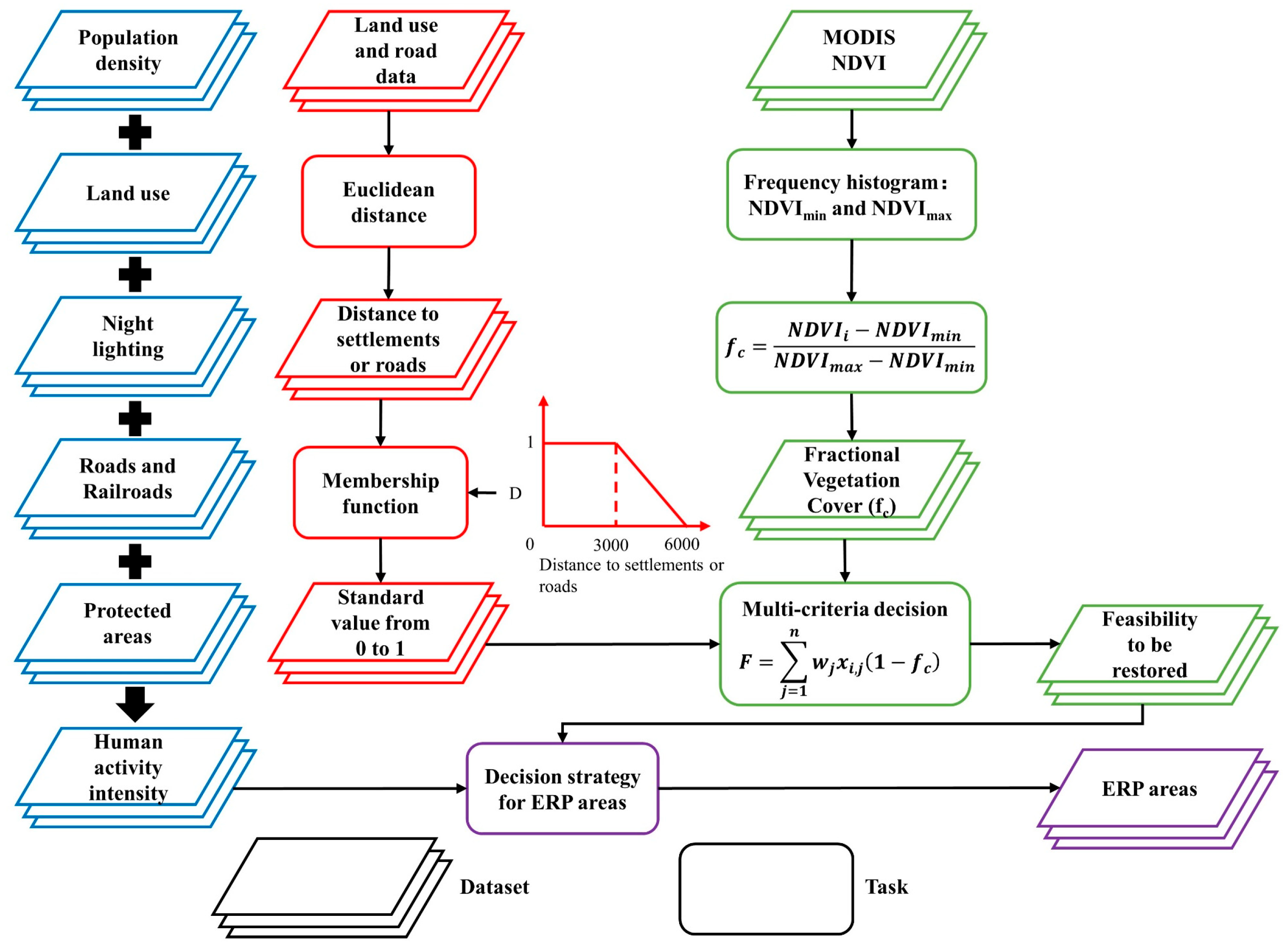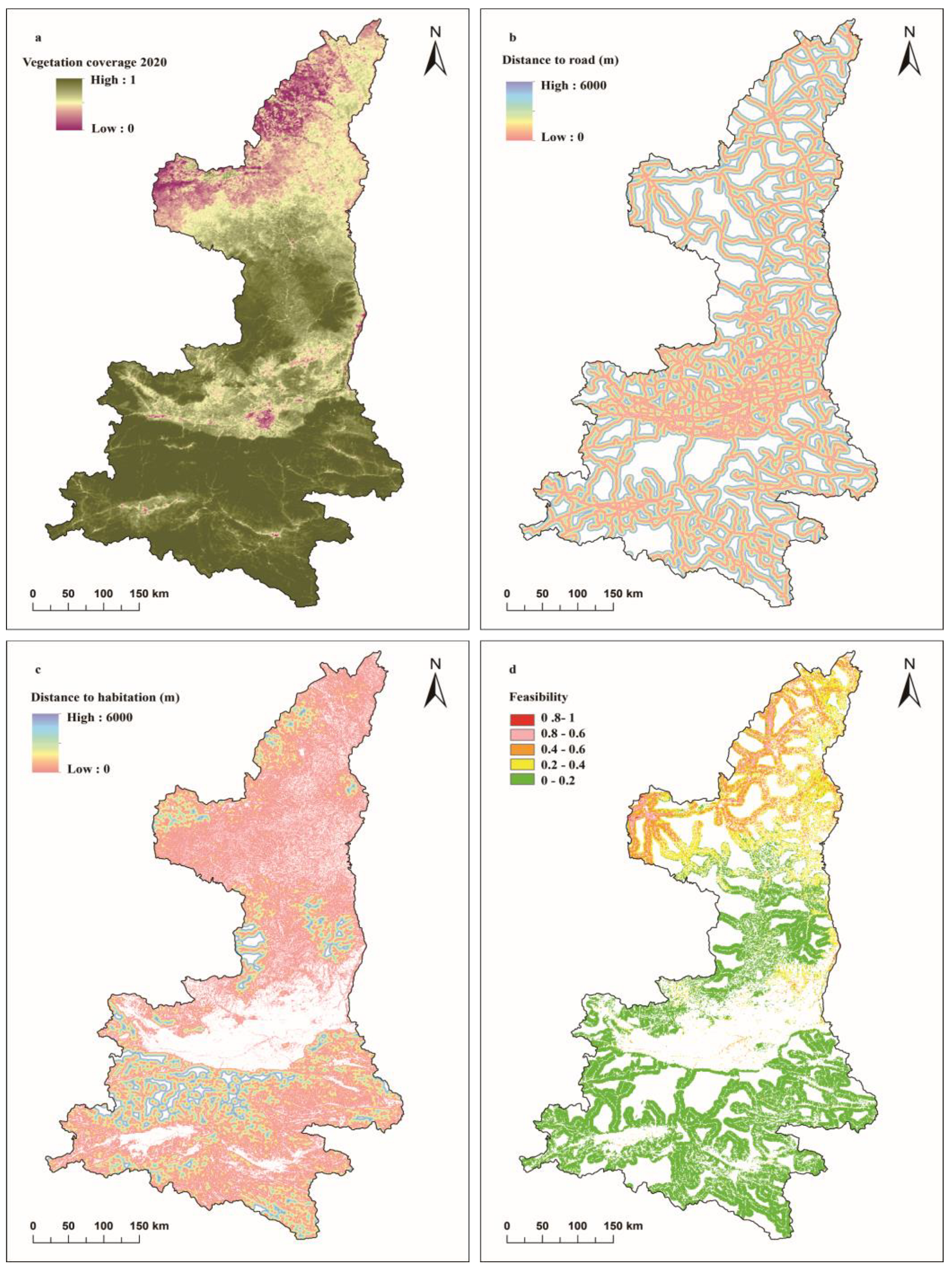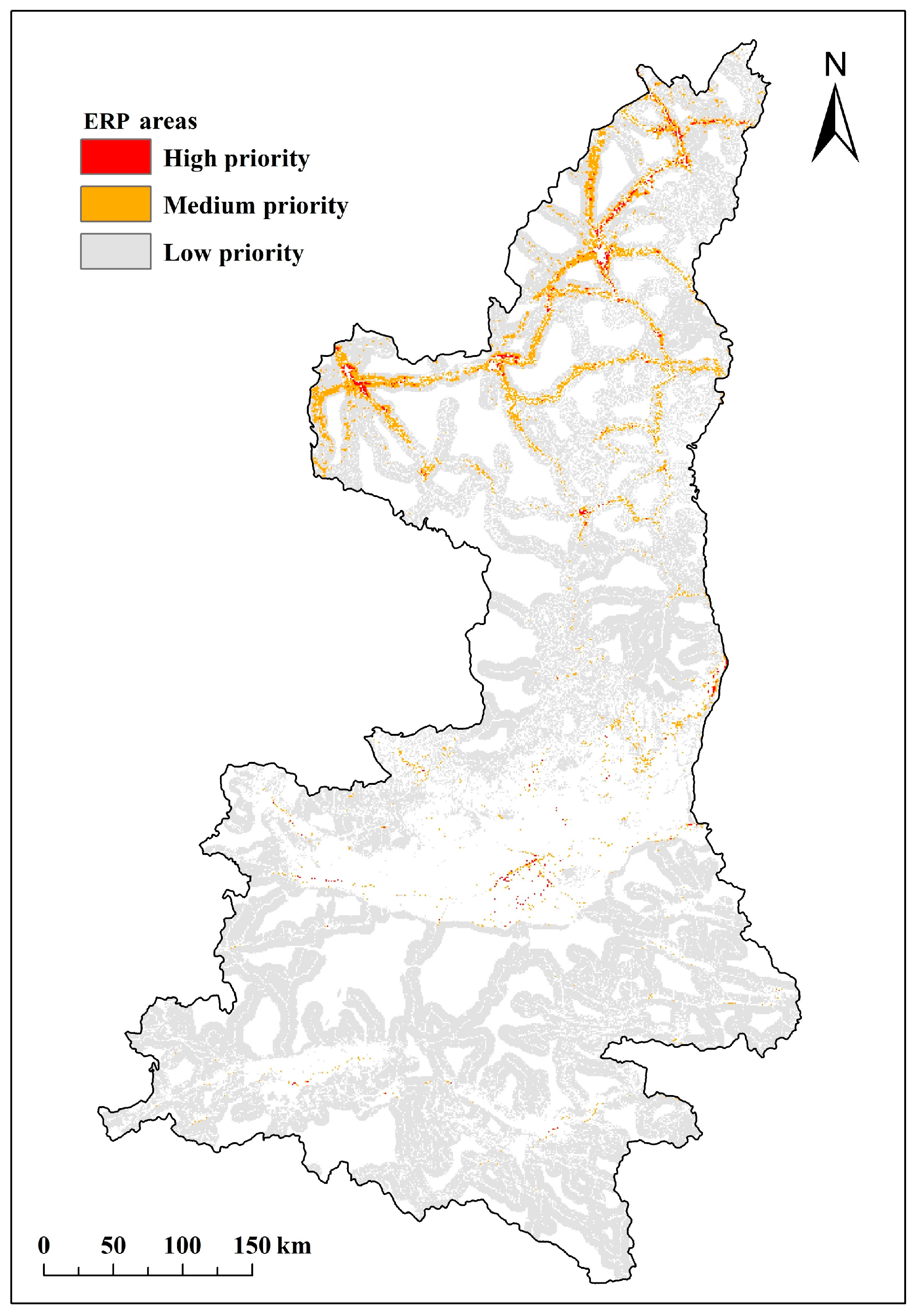Identification of Ecological Restoration Priority Areas Integrating Human Activity Intensity and Multi-Criteria Decision Analysis
Abstract
:1. Introduction
2. Data and Methods
2.1. Study Area
2.2. Datasets Sources
2.3. Vegetation Coverage
2.4. Determination of Feasibility to Be Restored
2.5. Index of Human Activity Intensity
2.5.1. Population Density
2.5.2. Land Use
2.5.3. Night Lighting
2.5.4. Roads and Railroads
2.5.5. Protected Areas
2.6. Determination of ERP Areas
3. Results
3.1. Feasibility Analysis
3.2. Human Activity Intensity
3.3. ERP Areas
4. Discussion
4.1. Methodology
4.2. Restoration Areas in Shaanxi
5. Conclusions
Author Contributions
Funding
Data Availability Statement
Conflicts of Interest
References
- Jiang, H.; Peng, J.; Dong, J.; Zhang, Z.; Xu, Z.; Meersmans, J. Linking Ecological Background and Demand to Identify Ecological Security Patterns across the Guangdong-Hong Kong-Macao Greater Bay Area in China. Landsc. Ecol. 2021, 36, 2135–2150. [Google Scholar] [CrossRef]
- Zhang, D.; Wang, X.; Qu, L.; Li, S.; Lin, Y.; Yao, R.; Zhou, X.; Li, J. Land Use/Cover Predictions Incorporating Ecological Security for the Yangtze River Delta Region, China. Ecol. Indic. 2020, 119, 106841. [Google Scholar] [CrossRef]
- Xie, H.; He, Y.; Choi, Y.; Chen, Q.; Cheng, H. Warning of Negative Effects of Land-Use Changes on Ecological Security Based on GIS. Sci. Total Environ. 2020, 704, 135427. [Google Scholar] [CrossRef] [PubMed]
- Wang, L.-J.; Ma, S.; Qiao, Y.-P.; Zhang, J.-C. Simulating the Impact of Future Climate Change and Ecological Restoration on Trade-Offs and Synergies of Ecosystem Services in Two Ecological Shelters and Three Belts in China. Int. J. Environ. Res. Public Health 2020, 17, E7849. [Google Scholar] [CrossRef] [PubMed]
- Aguirre-Salado, C.A.; Miranda-Aragón, L.; Pompa-García, M.; Reyes-Hernández, H.; Soubervielle-Montalvo, C.; Flores-Cano, J.A.; Méndez-Cortés, H. Improving Identification of Areas for Ecological Restoration for Conservation by Integrating USLE and MCDA in a GIS-Environment: A Pilot Study in a Priority Region Northern Mexico. ISPRS Int. J. Geo-Inf. 2017, 6, 262. [Google Scholar] [CrossRef]
- Fang, C.; Liu, H.; Li, G. International Progress and Evaluation on Interactive Coupling Effects between Urbanization and the Eco-Environment. J. Geogr. Sci. 2016, 26, 1081–1116. [Google Scholar] [CrossRef]
- Lü, Y.; Fu, B.; Feng, X.; Zeng, Y.; Liu, Y.; Chang, R.; Sun, G.; Wu, B. A Policy-Driven Large Scale Ecological Restoration: Quantifying Ecosystem Services Changes in the Loess Plateau of China. PLoS ONE 2012, 7, e31782. [Google Scholar] [CrossRef] [PubMed]
- De Mendonça, G.C.; Costa, R.C.A.; Parras, R.; de Oliveira, L.C.M.; Abdo, M.T.V.N.; Pacheco, F.A.L.; Pissarra, T.C.T. Spatial Indicator of Priority Areas for the Implementation of Agroforestry Systems: An Optimization Strategy for Agricultural Landscapes Restoration. Sci. Total Environ. 2022, 839, 156185. [Google Scholar] [CrossRef]
- Liu, Z.; Huang, Q.; Zhou, Y.; Sun, X. Spatial Identification of Restored Priority Areas Based on Ecosystem Service Bundles and Urbanization Effects in a Megalopolis Area. J. Environ. Manag. 2022, 308, 114627. [Google Scholar] [CrossRef]
- Silva, T.; Guimarães Vieira, I. Identification of Priority Areas for Ecological Restoration in Eastern Pará, Brazil. Floresta Ambiente 2020, 27, e014418. [Google Scholar] [CrossRef]
- Antongiovanni, M.; Venticinque, E.M.; Tambosi, L.R.; Matsumoto, M.; Metzger, J.P.; Fonseca, C.R. Restoration Priorities for Caatinga Dry Forests: Landscape Resilience, Connectivity and Biodiversity Value. J. Appl. Ecol. 2022, 59, 2287–2298. [Google Scholar] [CrossRef]
- Metzger, J. A Framework for Setting Local Restoration Priorities Based on Landscape Context. Nat. Conserv. Rev. Bras. Conserv. Nat. 2013, 11, 152–157. [Google Scholar] [CrossRef]
- Valente, R.A.; de Mello, K.; Metedieri, J.F.; Américo, C. A Multicriteria Evaluation Approach to Set Forest Restoration Priorities Based on Water Ecosystem Services. J. Environ. Manag. 2021, 285, 112049. [Google Scholar] [CrossRef] [PubMed]
- Vettorazzi, C.A.; Valente, R.A. Priority Areas for Forest Restoration Aiming at the Conservation of Water Resources. Ecol. Eng. 2016, 94, 255–267. [Google Scholar] [CrossRef]
- Castillo-Mandujano, J.; Smith-Ramírez, C. The Need for Holistic Approach in the Identification of Priority Areas to Restore: A Review. Restor. Ecol. 2022, 30, e13637. [Google Scholar] [CrossRef]
- Wang, H.; Liu, G.; Li, Z.; Zhang, L.; Wang, Z. Processes and Driving Forces for Changing Vegetation Ecosystem Services: Insights from the Shaanxi Province of China. Ecol. Indic. 2020, 112, 106105. [Google Scholar] [CrossRef]
- Su, C.; Fu, B. Evolution of Ecosystem Services in the Chinese Loess Plateau under Climatic and Land Use Changes. Glob. Planet. Change 2013, 101, 119–128. [Google Scholar] [CrossRef]
- Shifaw, E.; Sha, J.; Li, X.; Bao, Z.; Ji, J.; Chen, B. Spatiotemporal Analysis of Vegetation Cover (1984–2017) and Modelling of Its Change Drivers, the Case of Pingtan Island, China. Model. Model. Earth Syst. Environ. 2018, 4, 899–917. [Google Scholar] [CrossRef]
- Wang, H.; Li, Z.; Zhang, W.; Ye, X.; Liu, X. A Modified Temperature-Vegetation Dryness Index (MTVDI) for Assessment of Surface Soil Moisture Based on MODIS Data. Chin. Geogr. Sci. 2022, 32, 592–605. [Google Scholar] [CrossRef]
- Drobne, S.; Lisec, A. Multi-Attribute Decision Analysis in GIS: Weighted Linear Combination and Ordered Weighted Averaging. Informatica 2009, 33, 459–474. [Google Scholar]
- Ellis, E.C.; Ramankutty, N. Putting People in the Map: Anthropogenic Biomes of the World. Front. Ecol. Environ. 2008, 6, 439–447. [Google Scholar] [CrossRef]
- Venter, O.; Sanderson, E.; Magrach, A.; Allan, J.; Beher, J.; Jones, K.; Possingham, H.; Laurance, W.; Wood, P.; Fekete, B.; et al. Sixteen Years of Change in the Global Terrestrial Human Footprint and Implications for Biodiversity Conservation. Nat. Commun. 2016, 7, 12558. [Google Scholar] [CrossRef] [PubMed]
- Lu, Y.; Zhang, L.; Feng, X.; Zeng, Y.; Fu, B.-J.; Yao, X.; Li, J.; Wu, B. Recent Ecological Transitions in China: Greening, Browning, and Influential Factors. Sci. Rep. 2015, 5, 8732. [Google Scholar] [CrossRef] [PubMed]
- Xu, Y.; Xu, X.; Tang, Q. Human Activity Intensity of Land Surface: Concept, Methods and Application in China. J. Geogr. Sci. 2016, 26, 1349–1361. [Google Scholar] [CrossRef]
- Duan, Q.; Luo, L.; Zhao, W.; Zhuang, Y.; Liu, F. Mapping and Evaluating Human Pressure Changes in the Qilian Mountains. Remote Sens. 2021, 13, 2400. [Google Scholar] [CrossRef]
- Correa Ayram, C.A.; Mendoza, M.E.; Etter, A.; Pérez Salicrup, D.R. Anthropogenic Impact on Habitat Connectivity: A Multidimensional Human Footprint Index Evaluated in a Highly Biodiverse Landscape of Mexico. Ecol. Indic. 2017, 72, 895–909. [Google Scholar] [CrossRef]
- Duan, Q.; Luo, L. A dataset of human footprint over the Qinghai-Tibet Plateau during 1990–2015. China Sci. Data 2020, 5, 303–312. [Google Scholar]
- Etter, A.; McAlpine, C.A.; Seabrook, L.; Wilson, K.A. Incorporating Temporality and Biophysical Vulnerability to Quantify the Human Spatial Footprint on Ecosystems. Biol. Conserv. 2011, 144, 1585–1594. [Google Scholar] [CrossRef]
- Li, S.; Zhang, H.; Zhou, X.; Yu, H.; Li, W. Enhancing Protected Areas for Biodiversity and Ecosystem Services in the Qinghai–Tibet Plateau. Ecosyst. Serv. 2020, 43, 101090. [Google Scholar] [CrossRef]
- Huang, X.; Wang, X.; Zhang, X.; Zhou, C.; Ma, J.; Feng, X. Ecological Risk Assessment and Identification of Risk Control Priority Areas Based on Degradation of Ecosystem Services: A Case Study in the Tibetan Plateau. Ecol. Indic. 2022, 141, 109078. [Google Scholar] [CrossRef]
- Louzada, R.O.; Bergier, I.; Diniz, J.M.D.S.; Guerra, A.; Roque, F.D.O. Priority Setting for Restoration in Surrounding Savannic Areas of the Brazilian Pantanal Based on Soil Loss Risk and Agrarian Structure. J. Environ. Manag. 2022, 323, 116219. [Google Scholar] [CrossRef] [PubMed]
- Baró, F.; Gómez-Baggethun, E.; Haase, D. Ecosystem Service Bundles along the Urban-Rural Gradient: Insights for Landscape Planning and Management. Ecosyst. Serv. 2017, 24, 147–159. [Google Scholar] [CrossRef]
- Chen, X.; Li, F.; Li, X.; Liu, H.; Hu, Y.; Hu, P. Integrating Ecological Assessments to Target Priority Restoration Areas: A Case Study in the Pearl River Delta Urban Agglomeration, China. Remote Sens. 2021, 13, 2424. [Google Scholar] [CrossRef]
- Zhang, D.; Jia, Q.; Xu, X.; Yao, S.; Chen, H.; Hou, X. Contribution of Ecological Policies to Vegetation Restoration: A Case Study from Wuqi County in Shaanxi Province, China. Land. Use Policy 2018, 73, 400–411. [Google Scholar] [CrossRef]
- Tang, Y.; Shao, Q.; Liu, J.; Zhang, H.; Yang, F.; Cao, W.; Wu, D.; Gong, G. Did Ecological Restoration Hit Its Mark? Monitoring and Assessing Ecological Changes in the Grain for Green Program Region Using Multi-Source Satellite Images. Remote Sens. 2019, 11, 358. [Google Scholar] [CrossRef]
- Zhou, X.; Zhou, Y. Spatio-Temporal Variation and Driving Forces of Land-Use Change from 1980 to 2020 in Loess Plateau of Northern Shaanxi, China. Land 2021, 10, 982. [Google Scholar] [CrossRef]
- Li, Y.; Zhang, X.; Cao, Z.; Liu, Z.; Lu, Z.; Liu, Y. Towards the Progress of Ecological Restoration and Economic Development in China’s Loess Plateau and Strategy for More Sustainable Development. Sci. Total Environ. 2021, 756, 143676. [Google Scholar] [CrossRef]
- Zhang, K.; Zhang, Y.; Tian, H.; Cheng, X.; Dang, H.; Zhang, Q. Sustainability of Social–Ecological Systems under Conservation Projects: Lessons from a Biodiversity Hotspot in Western China. Biol. Conserv. 2013, 158, 205–213. [Google Scholar] [CrossRef]
- Zhang, Y.; Liu, X.; Lv, Z.; Zhao, X.; Yang, X.; Jia, X.; Sun, W.; He, X.; He, B.; Cai, Q.; et al. Animal Diversity Responding to Different Forest Restoration Schemes in the Qinling Mountains, China. Ecol. Eng. 2019, 136, 23–29. [Google Scholar] [CrossRef]
- Wang, J.; Zhao, M.; Zhong, W.; Li, J.; Zheng, C. Coupling Relationship of Urban Development and the Eco-Environment in Guanzhong Region, China. Sustainability 2022, 14, 2969. [Google Scholar] [CrossRef]
- Zhang, J.; Yu, Z.; Cheng, Y.; Sha, X.; Zhang, H. A Novel Hierarchical Framework to Evaluate Residential Exposure to Green Spaces. Landsc. Ecol. 2022, 37, 895–911. [Google Scholar] [CrossRef]
- De Carvalho, R.M.; Szlafsztein, C.F. Urban Vegetation Loss and Ecosystem Services: The Influence on Climate Regulation and Noise and Air Pollution. Environ. Pollut. 2019, 245, 844–852. [Google Scholar] [CrossRef]
- Liu, H.; Remme, R.P.; Hamel, P.; Nong, H.; Ren, H. Supply and Demand Assessment of Urban Recreation Service and Its Implication for Greenspace Planning—A Case Study on Guangzhou. Landsc. Urban Plan. 2020, 203, 103898. [Google Scholar] [CrossRef]
- Zardo, L.; Geneletti, D.; Pérez-Soba, M.; van Eupen, M. Estimating the Cooling Capacity of Green Infrastructures to Support Urban Planning. Ecosyst. Serv. 2017, 26, 225–235. [Google Scholar] [CrossRef]
- Wei, H.; Fan, W.; Ding, Z.; Weng, B.; Xing, K.; Wang, X.; Lu, N.; Ulgiati, S.; Dong, X. Ecosystem Services and Ecological Restoration in the Northern Shaanxi Loess Plateau, China, in Relation to Climate Fluctuation and Investments in Natural Capital. Sustainability 2017, 9, 199. [Google Scholar] [CrossRef]
- Shang, Y.; Lu, S.; Li, X.; Hei, P.; Lei, X.; Gong, J.; Liu, J.; Zhai, J.; Wang, H. Balancing Development of Major Coal Bases with Available Water Resources in China through 2020. Appl. Energy 2017, 194, 735–750. [Google Scholar] [CrossRef]
- Li, S.; Liang, W.; Fu, B.; Lü, Y.; Fu, S.; Wang, S.; Su, H. Vegetation Changes in Recent Large-Scale Ecological Restoration Projects and Subsequent Impact on Water Resources in China’s Loess Plateau. Sci. Total Environ. 2016, 569–570, 1032–1039. [Google Scholar] [CrossRef] [PubMed]
- Wen, X.-J.; Yang, H.-J.; Liu, Y.-X.; Jiang, C. Industrialization process and ecological risk pattern in a rich energy region of northern Shaanxi, Northwest China. Chin. J. Ecol. 2013, 32, 1578–1586. [Google Scholar]
- Li, S.; Yang, S.; Liu, X.; Liu, Y.; Shi, M. NDVI-Based Analysis on the Influence of Climate Change and Human Activities on Vegetation Restoration in the Shaanxi-Gansu-Ningxia Region, Central China. Remote Sens. 2015, 7, 11163–11182. [Google Scholar] [CrossRef]
- Ding, Z.; Yao, S. Assessing the Ecological Effectiveness of Sloping Land Conversion Programme to Identify Vegetation Restoration Types: A Case Study of Northern Shaanxi Loess Plateau, China. Ecol. Indic. 2022, 145, 109671. [Google Scholar] [CrossRef]





| Name | Type | Time | Resolution (m) | Sources |
|---|---|---|---|---|
| NDVI | Grid | 2020 | 250 | https://ladsweb.modaps.eosdis.nasa.gov, accessed on 1 September 2021 |
| Population density | Grid | 2020 | 250 | https://www.resdc.cn/, accessed on 7 September 2021 |
| Land use | Grid | 2020 | 300 | http://maps.elie.ucl.ac.be/CCI/viewer/, accessed on 3 September 2021 |
| Night lighting | Grid | 2020 | 250 | https://www.resdc.cn/, accessed on 7 September 2021 |
| Roads | Shapefile | 2020 | \ | https://www.resdc.cn/, accessed on 7 September 2021 |
| Railroads | Shapefile | 2020 | \ | https://www.resdc.cn/, accessed on 7 September 2021 |
| Protected areas | Shapefile | 2020 | \ | http://www.rcees.ac.cn/, accessed on 10 September 2021 |
| Data | Assignment | Method |
|---|---|---|
| Population density | 0–10 | popscore = 1.8527 × log(popdensity + 1) |
| Land use | 0, 2, 4, 7, 10 | 10 points to construction land, 7 points to farmland, 4 points to grassland and bare land, 2 points to forest, 0 points to water |
| Night lighting | 0–10 | Natural breakpoint method |
| Railroads | 8 | 8 points within 500 m on both sides |
| Roads | 4, 8, 10 | 10 points within 500 m on both sides 8 points within 500–1500 m on both sides 4 points within 1500–2500 m on both sides |
| Protected areas | \ | Downward by 8% |
| Human Activity Intensity | ||||||
|---|---|---|---|---|---|---|
| Very Low | Low | Middle | High | Very High | ||
| Feasibility to be restored | Very low | LP | LP | LP | LP | LP |
| Low | LP | LP | LP | MP | MP | |
| Middle | LP | LP | MP | MP | HP | |
| High | LP | MP | MP | HP | HP | |
| Very high | MP | MP | HP | HP | HP | |
Disclaimer/Publisher’s Note: The statements, opinions and data contained in all publications are solely those of the individual author(s) and contributor(s) and not of MDPI and/or the editor(s). MDPI and/or the editor(s) disclaim responsibility for any injury to people or property resulting from any ideas, methods, instructions or products referred to in the content. |
© 2023 by the authors. Licensee MDPI, Basel, Switzerland. This article is an open access article distributed under the terms and conditions of the Creative Commons Attribution (CC BY) license (https://creativecommons.org/licenses/by/4.0/).
Share and Cite
Wang, H.; Tang, B.; Li, W.; Zhang, W.; Liu, J.; Zhang, L.; Jiao, L. Identification of Ecological Restoration Priority Areas Integrating Human Activity Intensity and Multi-Criteria Decision Analysis. Forests 2023, 14, 2348. https://doi.org/10.3390/f14122348
Wang H, Tang B, Li W, Zhang W, Liu J, Zhang L, Jiao L. Identification of Ecological Restoration Priority Areas Integrating Human Activity Intensity and Multi-Criteria Decision Analysis. Forests. 2023; 14(12):2348. https://doi.org/10.3390/f14122348
Chicago/Turabian StyleWang, Hao, Butian Tang, Wenyi Li, Weijuan Zhang, Jiamin Liu, Liwei Zhang, and Lei Jiao. 2023. "Identification of Ecological Restoration Priority Areas Integrating Human Activity Intensity and Multi-Criteria Decision Analysis" Forests 14, no. 12: 2348. https://doi.org/10.3390/f14122348
APA StyleWang, H., Tang, B., Li, W., Zhang, W., Liu, J., Zhang, L., & Jiao, L. (2023). Identification of Ecological Restoration Priority Areas Integrating Human Activity Intensity and Multi-Criteria Decision Analysis. Forests, 14(12), 2348. https://doi.org/10.3390/f14122348







